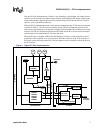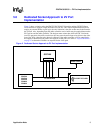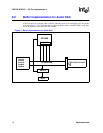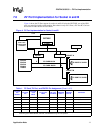
PD672X/30/32/33 — ZV Port Implementation
6 Application Note
2.0 Overview
This application note discusses system design considerations associated with the implementation
of the ZV (Zoomed Video) Port when using the PD6722/’29/’30, or PD6832 controller devices.
Intended to assist the system designer, this document highlights how various aspects of the PC
Card relate to the ZV Port implementation. Since the ZV Port implementation overlaps PC Card,
graphics, and audio technologies, consulting with appropriate applications/product groups is
recommended.
3.0 Zoomed Video (ZV)
ZV is a cost-effective method of accessing live video through a PC Card. The ZV Port provides a
direct connection between a PC Card and a VGA controller and an audio DAC. It allows the PC
Card to directly write video data to an input port of a graphics controller and audio data to a digital-
to-analog converter. Intel offers a family of PC Card (PCMCIA) Controllers that support the ZV
Port standard.
4.0 A Typical ZV Port Implementation
Figure 1 on page 7 illustrates a typical ZV Port implementation with PD6722/’29/’30 and PD6832
controller devices. These devices support the ZV Port in the ‘bypass’ mode during which the
signals are directly rerouted from the PC Card bus to the Video ZV Port (the video port of the
GD7XXX device is also referred to as the V-Port). This rerouting is accomplished by tristating
specific PC Card Bus signals from the PC Card (PCMCIA) Controller. Once these signals are
tristated by the host controller during the ZV Port operation, the ZV Port-compliant PC Card drives
video and audio data on the same signals. Video signals from the PC Card are routed to the ZV
Port-capable video controller; audio signals from the PC Card are routed to the ZV Port-compliant
audio DAC in the host system. This mechanism provides an inexpensive means of adding video/
audio capability to a notebook or desktop system without any additional burden on the host bus.
As specified in the PC Card standard, a ZV Port-compliant PC Card, when inserted into a PC Card
slot, is initialized the same way as a PC Card 16. It is then recognized as a ZV Port card and
programmed accordingly by Card Services. As shown in Figure 1, the PD6722/’29/’30/’6832
enters the ZV Port mode by tristating address pins A[25:4] of the PC Card bus when the
Multimedia Enable bit (bit 0 of the Misc. Control register 1 at index 16h in the PD6722/’29/’30 and
PD6832; in the PD6832 it can also be at memory offset 816h) is set. These address pins are outputs
from the PD6722/’29/’30/’6832 during normal PC Card operation. The tristating of the address
pins by the adapter allows the A[25:4] signals to simultaneously carry video data and video capture
timing control signals directly to a video controller, and the audio signals to the audio DAC. The
PD6832 has a Multimedia Arm bit (bit 7 of the Misc. Control register 3; this register is at I/O index
2Fh, extended index 25h, or memory offset 925h) that works as the overriding control bit. Until the
Multimedia Arm bit is set, the Multimedia Enable bit does not tristate the address bit as previously
described. When the Multimedia Expand bit (bit 6 of Misc. Control register 3) is set to ‘1’, CE2
and D[15:8] are tristated on the 16-bit PC Card bus, in addition to the tristating of the address
signals A[25:4]. The Multimedia Expand bus allows 24-bit video from the ZV Port-compliant PC
Card.

















